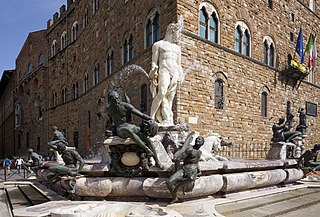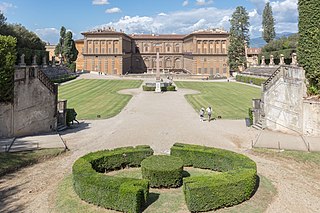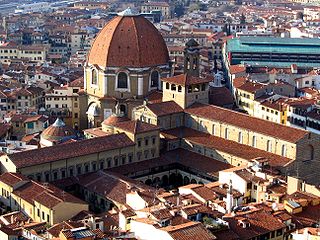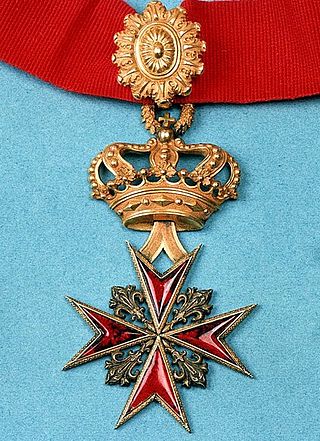
Bartolomeo Ammannati was an Italian architect and sculptor, born at Settignano, near Florence, Italy. He studied under Baccio Bandinelli and Jacopo Sansovino and closely imitated the style of Michelangelo.

The House of Medici was an Italian banking family and political dynasty that first consolidated power in the Republic of Florence under Cosimo de' Medici, during the first half of the 15th century. The family originated in the Mugello region of Tuscany, and prospered gradually until it was able to fund the Medici Bank. This bank was the largest in Europe during the 15th century and facilitated the Medicis' rise to political power in Florence, although they officially remained citizens rather than monarchs until the 16th century.

Giambologna, also known as Jean de Boulogne (French), Jehan Boulongne (Flemish) and Giovanni da Bologna (Italian), was the last significant Italian Renaissance sculptor, with a large workshop producing large and small works in bronze and marble in a late Mannerist style.

Cosimo I de' Medici was the second duke of Florence from 1537 until 1569, when he became the first grand duke of Tuscany, a title he held until his death.

The Boboli Gardens is a historical park of the city of Florence that was opened to the public in 1766. Originally designed for the Medici, it represents one of the first and most important examples of the Italian garden, which later served as inspiration for many European courts. The large green area is a real open-air museum with statues of various styles and periods, ancient and Renaissance that are distributed throughout the garden. It also has large fountains and caves, among them the splendid Buontalenti grotto built by the artist, architect, and sculptor Bernardo Buontalenti between 1536 and 1608.

The Palazzo Vecchio is the town hall of Florence, Italy. It overlooks the Piazza della Signoria, which holds a copy of Michelangelo's David statue, and the gallery of statues in the adjacent Loggia dei Lanzi.

The Medici Chapels are two chapels built between the 16th and 17th centuries as an extension to the Basilica of San Lorenzo, in the Italian city of Florence. They are the Sagrestia Nuova, designed by Michelangelo, and the larger Cappella dei Principi, a collaboration between the Medici family and architects. The purpose of the chapels was to celebrate the Medici family, patrons of the church and Grand Dukes of Tuscany.

Piazza della Signoria is a w-shaped square in front of the Palazzo Vecchio in Florence, Italy. It was named after the Palazzo della Signoria, also called Palazzo Vecchio. It is the main point of the origin and history of the Florentine Republic and still maintains its reputation as the political focus of the city. It is the meeting place of Florentines as well as the numerous tourists, located near Palazzo Vecchio and Piazza del Duomo and gateway to Uffizi Gallery.

The Duchy of Florence was an Italian principality that was centred on the city of Florence, in Tuscany, Italy. The duchy was founded after Pope Clement VII, himself a Medici, appointed his relative Alessandro de' Medici as Duke of the Florentine Republic, thereby transforming the Republic of Florence into a hereditary monarchy.

Pierre Francqueville, generally called Pietro Francavilla, was a Franco-Flemish sculptor trained in Florence, who provided sculpture for Italian and French patrons in the elegant Late Mannerist tradition established by Giambologna.

Santa Trinita is a Roman Catholic church located in front of the piazza of the same name, traversed by Via de' Tornabuoni, in central Florence, Tuscany, Italy. It is the mother church of the Vallumbrosan Order of Monks, founded in 1092 by a Florentine nobleman. South on Via de' Tornabuoni is the Ponte Santa Trinita over the river Arno; across the street is the Palazzo Spini Feroni.

The Order of Saint Stephen is a Roman Catholic Tuscan dynastic military order founded in 1561. The order was created by Cosimo I de' Medici, first Grand Duke of Tuscany. The last member of the Medici dynasty to be a leader of the order was Gian Gastone de Medici in 1737. The order was permanently abolished in 1859 by the annexation of Tuscany to the Kingdom of Sardinia. The former Kingdom of Italy and the current Italian Republic also did not recognize the order as a legal entity but tolerates it as a private body.

The Villa di Castello, near the hills bordering Florence, Tuscany, central Italy, was the country residence of Cosimo I de' Medici, Grand Duke of Tuscany (1519-1574). The gardens, filled with fountains, statuary, and a grotto, became famous throughout Europe. The villa also housed some of the great art treasures of Florence, including Sandro Botticelli's Renaissance masterpieces The Birth of Venus and Primavera. The gardens of the Villa had a profound influence upon the design of the Italian Renaissance garden and the later French formal garden.

Bindo Altoviti of the Altoviti family was an Italian banker and one of the most influential papal bankers of his generation. A patron of the arts, he cultivated close friendships with artists such as Benvenuto Cellini, Raphael, Michelangelo and Giorgio Vasari.

The Equestrian Monument of Ferdinando I is a bronze equestrian statue by Giambologna, executed in 1602–1607, and erected in 1608 in the Piazza of the Annunziata in Florence, region of Tuscany, Italy.

The Equestrian Monument of Cosimo I is a bronze equestrian statue executed by Giambologna from 1587 to 1594, and erected in 1594 in the Piazza della Signoria in Florence, Tuscany, Italy.
Antonio Altoviti was an Italian Catholic archbishop, son of Bindo Altoviti and archbishop of Florence from 1548 to 1573.

The Temple of Santo Stefano della Vittoria is a small chapel-church located in Pozzo della Chiana, a small hamlet near Foiano della Chiana in the province of Arezzo. The octagonal domed structure looms over the plain of Scannagallo, and was commissioned by Cosimo I de' Medici to commemorate his victory in 1554 over the forces of Siena.

The Altoviti are a prominent noble family of Florence, Italy. Since the medieval period they were one of the most distinguished banking and political families appointed to the highest offices of the Republic of Florence, friends and patrons of Galileo Galilei, Vasari, Raphael, and Michelangelo. They had a close personal relationship with the papacy. Through a predominant endogamous marriage policy they established alliances with dynasties of principal and papal nobility as the Medici, Cybo, Rospigliosi, Sacchetti, Corsini, and Aldobrandini.



















